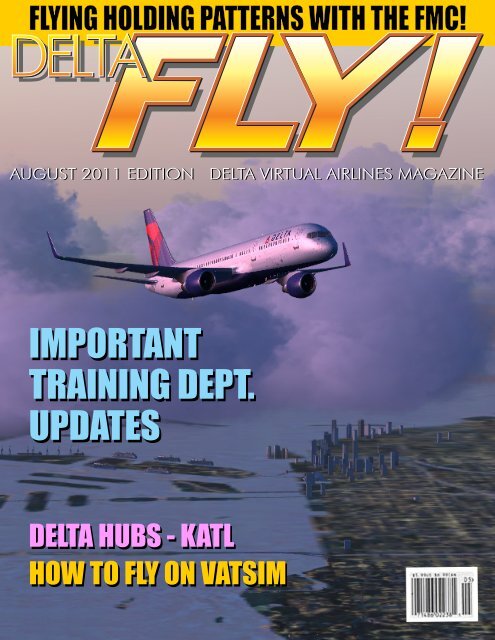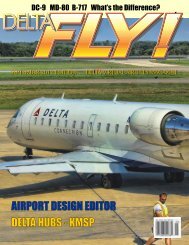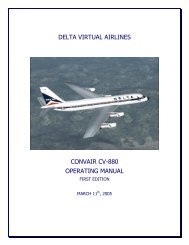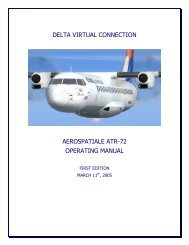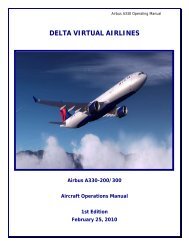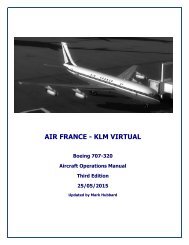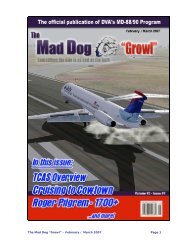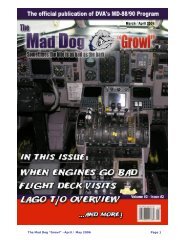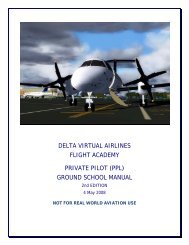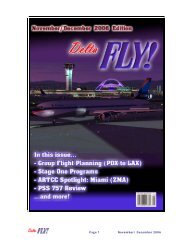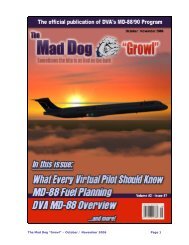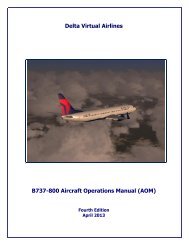August 2011 - Delta Virtual Airlines
August 2011 - Delta Virtual Airlines
August 2011 - Delta Virtual Airlines
Create successful ePaper yourself
Turn your PDF publications into a flip-book with our unique Google optimized e-Paper software.
FLYING HOLDING PATTERNS WITH THE FMC!<br />
AUGUST <strong>2011</strong> EDITION DELTA VIRTUAL AIRLINES MAGAZINE<br />
IMPORTANT<br />
TRAINING DEPT.<br />
UPDATES<br />
DELTA HUBS - KATL<br />
HOW TO FLY ON VATSIM
<strong>August</strong> <strong>2011</strong><br />
<strong>August</strong> <strong>2011</strong><br />
Issue #14<br />
Editor - Tom Housworth<br />
editor@deltava.org<br />
Asst. Editor/Graphics - Skip Simpson<br />
Asst. Editor/Content - Trevor Bair<br />
Front Cover: B752 departing KMIA by Tom Housworth<br />
Photos and Screenshots courtesy of:<br />
B738 by Jim Wilkinson.................pg 2<br />
B752 by Dave Keech....................pg 7<br />
B737 Cockpit by Freddy Carhaus..pg 10<br />
MD11 by Vic DeSantis..................pg 10<br />
EMB120’s by Jim Pray...................pg 17<br />
B738 by Brandon Howell..............pg 17<br />
L1011 Cockpit by Don Baker........pg 18<br />
KATL Real Ops by Trevor Bair........pg 18<br />
B748I by Moiz Shakeel.................pg 19<br />
B777 by Moiz Shakeel..................pg 22<br />
Convair by Ronald Pearson...........pg 22<br />
L1011 by Andy Kaufmann............pg 23<br />
If you want your photo to be considered for use in a future<br />
edition of <strong>Delta</strong> FLY!, send an email to the address listed in<br />
this section with the subject <strong>Delta</strong> FLY! Photo.<br />
Please do not send the photo itself, but instead provide a<br />
link to the photo (i.e., from the Water Cooler). If you have<br />
to send the photo itself, send it to editors email address<br />
listed above.<br />
Photos must be your own work. Please do not recommend<br />
photos that are not yours. Photo copyrights belong to the<br />
original author and will not be used without permission. If<br />
you want a photo to be used as filler within <strong>Delta</strong> FLY!, the<br />
same rules apply.<br />
INSIDE THIS ISSUE:<br />
Inside This Issue pg 2<br />
President’s Letter pgs 3-4<br />
Events Update pg 5<br />
<strong>Delta</strong> Hubs pg 6<br />
Dispatch Desk pg 7<br />
Training/Flight Academy pgs 8-9<br />
Test Pilot pg 10<br />
Holding Patterns pg 11-13<br />
Wingnutz & David Keech Bio pg 14<br />
How To Fly On VATSIM pg 15-16<br />
Chief Pilot Updates pgs 17-18<br />
A Face With A Name pg 19<br />
From The Editor’s Desk pg 20<br />
Transition Is The Key Word pgs 21-22<br />
Parting Shots<br />
back cover<br />
<strong>Delta</strong> <strong>Virtual</strong> <strong>Airlines</strong> (DVA) is in no way affiliated with <strong>Delta</strong> Air Lines or any of its subsidiaries. The information contained in this<br />
document is for flight simulation use only. This document is freeware only.<br />
All Rights Reserved. This publication may not be reproduced, in part or its entirety, without the expressed permission of DVA and the<br />
Editor. Images used are copyrighted by their respective owners.<br />
2<br />
<strong>August</strong> <strong>2011</strong>
From the<br />
Presidents Desk<br />
Terry Eshenour - Senior Captain B777<br />
<strong>August</strong> <strong>2011</strong><br />
Fellow Pilots,<br />
th<br />
We are progressing through our 11 year with a robust and energetic group of pilots and support staff. Recent<br />
staff changes are the result of real-world time constraints. Our system has new tools to support our staff as they<br />
provide service.<br />
The Career Opportunities feature provides an efficient process to receive staff candidate applications. We’ve<br />
had a few startup glitches that were readily resolved. If you are interested in supporting the community at the<br />
staff level, I urge you to apply. Should you not succeed at first, continue to apply. We have a large talent pool and<br />
only a few positions. Be patient and your time to serve will come.<br />
The Flight Academy, under the guidance of Scott Clarke and Jim Warner, in coordination with VATSIM created<br />
a program back in March, that enables us to award Online Pilot certification. The program is self-administered<br />
with an online Check Ride that is reviewed by a Flight Instructor. The Flight Academy is busy working on other<br />
instruction modules. Stay tuned, as they will have additional announcements throughout the remainder of this<br />
year.<br />
I receive inquiries about how we provide the professional level of services without user fees or advertising.<br />
st<br />
Since we are approaching September 1 the start of our fiscal year, I thought that I would use my space to share<br />
with you background information about how we are structured and what keeps <strong>Delta</strong> <strong>Virtual</strong> <strong>Airlines</strong>, the<br />
largest single virtual airline, available 24/7.<br />
The time, effort and talent that staff provides is volunteer. No one receives financial compensation. For<br />
example, the computer code and server administration is provided by Luke Kolin, a professional software<br />
development engineer with a passion for excellence and fortunately for us, an interest in an aviation<br />
community of like-minded individuals. A commercial airline pilot, Ken Nesbitt, who is able to share real world<br />
aviation experiences when dealing with our structure and management of line staff, heads the operations side<br />
of <strong>Delta</strong> <strong>Virtual</strong> <strong>Airlines</strong>. The Flight Academy has several participants who are commercial aviators and certified<br />
instructors.<br />
The major operating cost is the dedicated server and Internet connectivity. We use a dedicated server located at<br />
a commercial computer processing center to handle our website and related data processing needs. The server<br />
is about to complete 1,000 days of uninterrupted service. Luke advises me that it is nearing the end of its<br />
expected service life. Plans are underway to replace it and to provide a backup server.<br />
So you are thinking, how are the bills paid for the server and Internet connectivity? The short answer is by pilot<br />
volunteer contributions.<br />
.<br />
3<br />
<strong>August</strong> <strong>2011</strong>
Then you ask, how and to whom are the contributions made? This is where Global <strong>Virtual</strong> <strong>Airlines</strong> Group plays<br />
an important function. It was created to provide an overall corporate entity to own software rights, domain<br />
names and provide a set of policies for creating budgets and receiving contributions. Global <strong>Virtual</strong> <strong>Airlines</strong><br />
Group has two subsidiaries, Aviation Français Virtuel Airline and <strong>Delta</strong> <strong>Virtual</strong> <strong>Airlines</strong>.<br />
So how does this all work? At the end of the fiscal year, <strong>August</strong>, the treasurer summarizes expenditures and<br />
provides a spending plan for the next year. The information is supplied to the volunteer contributors, who are<br />
“shareowners.” The term shareowner and shares are used simply to identify a portion of the expenses paid by<br />
the contribution. Currently one portion or share is $10 of contribution. The shareowners are asked to ratify the<br />
report and proposed spending plan.<br />
The prior year “shareowners” or contributors are given first opportunity to purchase “shares” for the new year.<br />
Any remaining shares are offered to those who volunteer to contribute. If you are interested in being a<br />
volunteer, make your intentions known to the Treasurer of Global <strong>Virtual</strong> <strong>Airlines</strong> Group<br />
Treasurer@GVAGroup.org<br />
Thank you for indulging my description of how things work. I realize that it is not exciting and fun, but it is a<br />
necessary part that assures that we can continue providing services.<br />
Wishing you all blue sky and smooth air!<br />
Thank you for flying <strong>Delta</strong> <strong>Virtual</strong> <strong>Airlines</strong>,<br />
Terry Eshenour<br />
President, Senior Captain<br />
DVA057<br />
4<br />
<strong>August</strong> <strong>2011</strong>
From the<br />
Events Department<br />
Luke Jones - Senior Captain A330<br />
Hello DVA,<br />
The Events staff would like to say thanks for all the support you have given during each and every event. Your participation<br />
has kept us going and makes our efforts worthwhile. Over the past few months, we added a new member, Dylan Neidorff to our staff.<br />
We are happy to have him, and he has already provided numerous interesting and fun events. Looking ahead, the DVA Events staff<br />
WILL BE hosting another “Long Haulers” event which is in the early stages of construction. Additionally look for an event that takes<br />
participants to the heart of Central America, Honduras. This is one of the world's most difficult approaches and will sure to challenge<br />
everyone’s piloting skills. All in all, the events in the next few months promise to be fun and interesting for everyone. Stay tuned in<br />
the Water Cooler for more updates on new events and enjoy every hour in the sky.<br />
Blue Skies,<br />
DVA Events Staff<br />
Dylan Neidorff, Age 23, is an<br />
Assistant Director of Events for<br />
<strong>Delta</strong> <strong>Virtual</strong> <strong>Airlines</strong>. He is a 1st<br />
Lieutenant in the United States<br />
Air Force, currently stationed at<br />
Hanscom Air Force Base in<br />
Massachusetts.<br />
Dylan grew up on Long Island.<br />
He took his first flight at 12 years<br />
old, which ignited the ambition<br />
to obtain his Private Pilot License.<br />
On Aug 22nd, 2005 he obtained<br />
his PPL at Long Island, Islip<br />
Airport followed by his Instrument Rating in December 2007.<br />
He currently has over 300 hours<br />
and over 500 landings logged in<br />
a multitude of aircraft. Dylan flies<br />
the Cessna 172 & 182 but has<br />
logged time in the Cirrus 22 and<br />
Citation Mustang.<br />
In 2005, Dylan began his<br />
adventure towards a Bachelors<br />
D e g r e e i n M e c h a n i c a l<br />
Engineering. He called Boston<br />
University home for four years<br />
until 2009, when he graduated.<br />
During his four years of college<br />
Dylan joined Air Force ROTC at DET 355. In May 2009, Dylan<br />
graduated not only with his Bachelors Degree but also with a<br />
Commission in the United States Air Force. Even though Dylan<br />
tried to become a pilot for the Air Force, only to be medically<br />
disqualified, Dylan was classified as a 62EX, Project Engineer.<br />
For his first two years in the Air Force, Dylan worked as a project<br />
manager for software used within the Special Operations<br />
Community. He is currently working on a special rapid<br />
prototyping project for the Department of Homeland Security<br />
at Eglin AFB, FL.<br />
Dylan is a Captain in the 777 and has over 1,200 hours logged<br />
with DVA. He is also a controller for New York on VATSIM. He<br />
primarily works JFK airspace up to and including Approach<br />
Control. He is also an active Senior Member in the Civil Air<br />
Patrol, volunteering his time to Cadet Programs at the Hanscom<br />
Composite Squadron. Dylan is always welcoming questions<br />
about his experience and has the drive to help others. Please let<br />
him know if he can help out with anything!<br />
dylan_neidorff@deltava.org or djnaf62@gmail.com<br />
Comprende METAR?<br />
this is a great link to check out<br />
http://www.wunderground.com/metarFAQ.asp<br />
5<br />
<strong>August</strong> <strong>2011</strong>
DELTA HUBS<br />
Hartsfield–Jackson Atlanta Intl. Airport<br />
had its beginnings on an abandoned<br />
auto racetrack. The lease was signed on<br />
April 16, 1925, by Mayor Walter Sims,<br />
who committed the city to develop it<br />
into an airfield. As part of the<br />
agreement, the property was renamed<br />
Candler Field after its former owner,<br />
Coca-Cola tycoon and former Atlanta<br />
mayor Asa Candler. The first flight into<br />
Candler Field was a Florida Airways<br />
mail plane flying from Jacksonville,<br />
Florida on September 15, 1926. In<br />
May 1928, Pitcairn Aviation began<br />
service to Atlanta, followed in June<br />
1930 by <strong>Delta</strong> Air Service. Later these<br />
two airlines, known as Eastern Air Lines<br />
and <strong>Delta</strong> Air Lines, respectively, would<br />
both use Atlanta as their chief hubs.<br />
During WWII the US Government<br />
declared it a "Military Airfield" and the<br />
US Air Force operated Atlanta Army<br />
Airfield.<br />
In 1946, the airport was renamed<br />
Atlanta Municipal Airport and by 1948<br />
<strong>Delta</strong>, Eastern and Southern Airways<br />
were operating an extensive route<br />
network to many destinations<br />
throughout the United States.<br />
As the Aviation Industry and Air Carrier<br />
operations grew, the Airport struggled<br />
to keep up with passenger demand,<br />
both domestic and internationally. In<br />
May of 1961 a new $21 million dollar<br />
terminal opened and was the largest in<br />
the country. Able to accommodate<br />
over 6 million passengers a year, it<br />
exceeded its capacity the first year with<br />
9.5 million passengers.<br />
In 1967 the city of Atlanta and airlines<br />
began work on a Master Plan for future<br />
development of Atlanta Municipal<br />
Airport. January 1977 construction<br />
began on the<br />
$500 million<br />
dollar present<br />
day midfield<br />
t e r m i n a l .<br />
Named for<br />
f o r m e r<br />
A t l a n t a<br />
Mayor, the<br />
William B.<br />
Hartsfield International Airport<br />
opened September 21, 1980. It was<br />
designed to accommodate up to 55<br />
million passengers per year and<br />
covered 2.5 million square feet.<br />
October 2003 Atlanta's City Council<br />
voted to change the name to its<br />
current Hartsfield-Jackson Atlanta<br />
International Airport in honor of<br />
Maynard Jackson, the first African-<br />
American Mayor who died that year.<br />
The airport today employs<br />
approximately 55,300 airline,<br />
g r o u n d t r a n s p o r t a t i o n ,<br />
concessionaire, security, federal<br />
government, City of Atlanta and<br />
Airport tenant employees and is<br />
considered the largest employment<br />
center in the state of Georgia. With a<br />
payroll of $2.4 billion, the airport<br />
has a direct and indirect economic<br />
impact of $3.2 billion on the local<br />
and regional economy and a total<br />
annual, regional economic impact<br />
of more than $19.8 billion dollars.<br />
World’s Busiest<br />
Airport<br />
Airports Council<br />
International in<br />
Geneva,<br />
Switzerland has<br />
ranked<br />
Hartsfield-<br />
Jackson<br />
International<br />
Airport #1 in the<br />
following<br />
categories:<br />
ŸLargest numbers<br />
of passengers<br />
annually 1998-<br />
present<br />
ŸMost arrivals &<br />
departures<br />
1999-2000,<br />
2005 -present<br />
ŸMost flights<br />
2006<br />
6<br />
<strong>August</strong> <strong>2011</strong>
From the<br />
Dispatch Desk<br />
David Keech - Senior Captain B727<br />
<strong>Delta</strong> Dispatch and Real Ops<br />
On Saturday, June 18, <strong>2011</strong>, <strong>Delta</strong> <strong>Virtual</strong> <strong>Airlines</strong>,<br />
partnering with Salt Lake ARTCC (ZLC), conducted an<br />
event on a massive scale. Real World Ops took the best of<br />
the Real World and transposed it into our <strong>Virtual</strong> World.<br />
Pilots signed up for a designated departure or arrival flight<br />
into and out of Salt Lake City International Airport (KSLC).<br />
Being a hub for our real world counterpart, flights were<br />
staggered and staged like a real push. I cannot express my<br />
satisfaction as to how smoothly this event turned out to be.<br />
Sure we had some issues, but we worked through them and<br />
were able to push some tin. <strong>Delta</strong> Dispatch provided<br />
clearance and squawk code for each aircraft departing SLC.<br />
Luke Jones, Events Director, provided ramp services for our<br />
fleet. Like in the real world, pilots got their clearances from<br />
the DVA Dispatcher and verified the squawk code. They in<br />
turn contacted the Ramp Controller, once connected to<br />
Vatsim. They were then instructed push, start and taxi to a<br />
hold spot, just like in the RW. Once at that spot, they were<br />
switched over to ground. When it worked well, aircraft<br />
flowed out of the terminal easily. Arriving aircraft were<br />
again switched over to the Ramp frequency when entering<br />
the ramp area.<br />
ZLC was happy to have the traffic and it seems our<br />
neighboring ARTCC's got the overflow.<br />
What we learned most was that a lot of people haven't<br />
used Dispatch in the past. I highly encourage<br />
everyone to try to use the client and more importantly<br />
a live Dispatcher before they fly their next flight. Many<br />
who flew the event were amazed at what it can do.<br />
Don't be scared, we don't bite! The lessons learned<br />
from this event will carry through to our next event.<br />
Until then, enjoy the program for all its intents and<br />
purposes, and be careful of the Wasatch mountain<br />
range, like below when departing SLC to the east!<br />
Special thanks to Scott Clarke and Jon Snoops and the<br />
rest of the ZLC ARTCC team for letting us play in their<br />
backyard, to Tom Housworth for slaving over the<br />
Dispatch screen for several hours, Luke Jones for<br />
playing Ramp Controller and putting this all together<br />
with Dylan Neidorff and most of all, the pilots for their<br />
patience and understanding who flew this event. You<br />
guys ROCK!<br />
B752 by Dave Keech<br />
7<br />
<strong>August</strong> <strong>2011</strong>
From the<br />
VP of Training<br />
Scott Clarke - Senior Captain DC8-61<br />
<strong>Delta</strong> <strong>Virtual</strong> Flight Academy<br />
<strong>Delta</strong> <strong>Virtual</strong> Flight Academy received its VATSIM Authorized (normal and cross-wind), airport traffic patterns, entry and<br />
Training Organization (ATO) certification on December 30, departure procedures, flight at various airspeeds from cruise<br />
2010. In the past seven months, we have graduated 200+ to slow flight and ground reference maneuvers.<br />
pilots in our <strong>Delta</strong> <strong>Virtual</strong> OnLine Pilot course (OLP) which<br />
qualifies them to receive the VATSIM P1 rating.<br />
Commercial OnLine Pilot<br />
This course was the beginning of a new computer training This advanced course will get the student candidate ready for<br />
approach for the <strong>Delta</strong> <strong>Virtual</strong> Flight Academy, originally the IFR OnLine Pilot course with tighter flying requirements<br />
started in 2006 by George Lewis, to provide individual and cross-country flying on VATSIM. The written portion of<br />
training and current information to its members on the virtual this course will emphasize commercial knowledge standards<br />
flying hobby. With this revamped program, more students in such areas as weather information, cross-country flight<br />
have been able to learn and take the course(s) at their own planning and national airspace system.<br />
pace and participate in our programs.<br />
The flying portion of this course will cover collision avoidance,<br />
The next stage will be the introduction of the following wind shear avoidance, wake turbulence avoidance, normal<br />
courses: (1) VFR OnLine Pilot (2) Commercial OnLine Pilot and crosswind takeoff and climb, short and soft field<br />
(3) IFR OnLine Pilot and (4) ATP OnLine Pilot. All of these operations, steep turns, stalls, spins, emergency approaches,<br />
courses will mirror the established course outline of the landings and flying on VATSIM.<br />
OnLine Pilot course(OLP); computer based knowledge using<br />
<strong>Delta</strong> VA created manuals and articles, AIM, FAA training IFR OnLine Pilot<br />
handbooks and other aviation resources available to our<br />
pilots. We have created a pool of test questions on many Using the current FAA Instrument Flying Handbook, course<br />
subjects using this knowledge base to challenge our pilots. syllabus and practical flying exams as our knowledge and<br />
Each course will be completed with a satisfactory passing of testing data base, this course will be the most difficult and<br />
ACARS based stage checks (check rides), so the pilot can rewarding for the virtual pilot. It will include heavy emphasis<br />
demonstrate his flying skills and knowledge to our instructors. on chart reading, precision and non-precision approaches,<br />
SID/STAR flying etc., inclement weather and low ceilings will<br />
Our courses will be submitted to VATSIM at the end of their add to the realism of this course. By using our new ACARS<br />
development in order to receive the ATO approval.<br />
program, there will be number of instrument stage check rides<br />
to test the pilot's practical flying skills and abilities.<br />
VFR OnLine Pilot<br />
The candidate for this course must have completed the<br />
This course will emphasize VFR knowledge, procedures and OnLine Pilot(OLP), VFR and Commercial Online pilot courses<br />
flying. The pilot candidate will learn about visual flying and have at least 50 hours of cross-country flight time as pilot<br />
techniques, basic navigation and instrument work. VFR ATC in command logged on ACARS and VATSIM. Each crossvoice<br />
communications and flying VFR on VATSIM will be country must have a landing at an airport that is at least a<br />
demonstrated and graded using our ACARS based check straight-line distance of more than 50 NM from the original<br />
rides.<br />
departure point.<br />
The candidate will be able to demonstrate their knowledge in<br />
The written test will require aeronautical knowledge in air traffic control clearances and procedures, flight by<br />
airspace rules and procedures for the airport where the solo reference to instruments, navigation systems, instrument<br />
flight will be performed, flight characteristics and operational approach procedures and emergency operations.<br />
limitations of the aircraft to be flown. One of the ACARS check rides will consist of a flight of 250<br />
The pilot will demonstrate flying maneuvers and procedures nautical miles along airways or by directed routing from an air<br />
appropriate to the aircraft to be flown, including, taxiing or traffic control facility with an instrument approach at each<br />
surface operations, engine run-ups, takeoffs and landings airport and three different kinds of approaches with the use of<br />
8<br />
<strong>August</strong> <strong>2011</strong>
navigation systems. Other ACARS check rides will test the<br />
piloting and navigation skills of the virtual pilot.<br />
ATP OnLine Pilot<br />
Completion of this course will recognize the virtual pilot who<br />
has been tested to the highest level of piloting and<br />
demonstrates the knowledge and flying skills to handle all<br />
phases of <strong>Virtual</strong> Airline flying.<br />
The academy will be developing individual courses as<br />
needed, such as “Cross the Pond” flying, “How to fly a DVA<br />
Event”, advanced aircraft flying programs and a program<br />
“check pilot” position for many of the aircraft stage programs.<br />
Note: The information contained in our courses and flight<br />
academy programs is for flight simulation use only.<br />
Looking forward to seeing you in one of the many Flight<br />
Academy courses in the future.<br />
We are always looking for more staff and instructors and<br />
we feel that we have some of the best at <strong>Delta</strong> <strong>Virtual</strong> in the<br />
Academy.<br />
Jim Warner (DVA2533) Director of the <strong>Delta</strong> <strong>Virtual</strong> Flight<br />
Academy<br />
Andy Kaufmann (DVA3931) Instructor - develops training<br />
programs for ACARS, Squawkbox, FSINN and has helped<br />
the academy develop its document library with such topics as<br />
“How to Read Charts” and the “ACARS manual” for the<br />
Academy check ride flights.<br />
Michael Brown (DVA 3196) Instructor - Michael helps our<br />
students to progress through the various courses, submits<br />
check ride reviews, responds to questions and various other<br />
administrative tasks.<br />
Three new instructors have joined the Flight Academy to<br />
work on these new courses.<br />
New additions are:<br />
Danny Hull (DVA 3191)<br />
James “Danny” Hull (DVA 3191) is a recent addition in the<br />
<strong>Delta</strong> <strong>Virtual</strong> Flight Academy as a flight instructor. Danny<br />
began flying flight sims in 1996 and joined <strong>Delta</strong> <strong>Virtual</strong><br />
<strong>Airlines</strong> in 2006. He is presently a Captain and flies a B747-<br />
400.<br />
Currently holding an real world ATP and Combat Fighter Pilot<br />
ratings, he flies an F16C for the USAF. He started flying out of<br />
Centennial Airport in Denver at the age of 13, flew gliders for<br />
a few years and soloed at 16. At 17, he began working on his<br />
single engine PPL, and earned that in May 2000. He then<br />
attained Instrument, Commercial, and Multi-Engine<br />
Commercial ratings and was subsequently hired by Great<br />
Lakes <strong>Airlines</strong> in Dec of 2004 and flew with them for a year<br />
before leaving for Air Force pilot training. He has flown<br />
everything from a C-172, B-1900D to the F-16C.<br />
In his spare time, Danny enjoys the outdoors, playing sports,<br />
traveling or going on cross-country flights. He likes to fly<br />
aerobatics in his uncles RV-4. He says his favorite maneuver is<br />
the hammer head.<br />
Danny will be working on the development of the new VFR<br />
Online Pilot, Commercial, Instrument and ATP courses for<br />
the Flight Academy.<br />
Matt Young (DVA 1008)<br />
Matt joined <strong>Delta</strong> VA in 2002 and is a Senior Captain in the<br />
DC-8 program. He started simming with Flight Unlimited II<br />
in 1998 and then switched to the FS series in 2001 shortly<br />
before FS2002 came out.<br />
He has been flying since he was a small child because his Dad<br />
has always had a plane, and he finally took the plunge and got<br />
his certificate, after anticipating a need for business travel.<br />
Presently a Purdue engineering student, Matt continues<br />
working to complete his instrument rating. He will be<br />
developing the many knowledge-base documents and<br />
course outlines needed in the flight academy.<br />
Lionel M. Holguin, Jr. (DVA 4583)<br />
Lionel M. Holguin, Jr. (DVA 4583) began flying flight<br />
simulation in 1995 and joined <strong>Delta</strong> <strong>Virtual</strong> airlines in 2007.<br />
He has served DVA as the Boeing 777 program Assistant<br />
Chief Pilot and he is presently a Senior Captain in the DC-8-<br />
61 program where he flies a Boeing 707-332 .<br />
He started flying a Cessna-152 at the Albuquerque, NM.<br />
Coronado Airport, and has flown the Beechcraft King Air<br />
350, Beechcraft 1900C/D and C-12. After leaving the U.S.<br />
Army, he worked on the RAH-66 Comanche program where<br />
he worked on the transfer of technology from the cancelled<br />
program to present day AH-64D, UH-60 and CH-47<br />
rotorcraft airframes.<br />
Lionel presently works for the U.S. Army Aviation Missile<br />
Lifecycle Management Command [AMCOM], where he<br />
serves as the Program Manager for the Non-Standard<br />
Commercial Fixed Wing and Rotorcraft for Foreign Military<br />
Sales cases. He has also taught Computer Science at Athens<br />
State University as an adjunct professor of science for the past<br />
seven years.<br />
Lionel will be working on the development of the new<br />
Online Pilot courses for the Flight Academy.<br />
NEWS<br />
<strong>Delta</strong> <strong>Virtual</strong> and the <strong>Delta</strong> Flight Academy were featured in<br />
the Feb <strong>2011</strong> article “<strong>Virtual</strong>ly Real” written by Chuck<br />
Weirauch in The Journal for Civil Aviation Training on page<br />
32. You can find the article at:<br />
http://www.halldale.com/magazines/cat/issues/cat-2<strong>2011</strong><br />
9<br />
<strong>August</strong> <strong>2011</strong>
1) When air molecules speed up, the pressure they exert:<br />
A) Decreases<br />
B) Increases<br />
C) Increases, then decreases<br />
D) Doesn't change<br />
2) By land area, what is the largest airport in the United<br />
States?<br />
A) Atlanta Hartsfield-Jackson International Airport<br />
B) Los Angeles Internal Airport<br />
C) Chicago O'Hare International Airport<br />
D) Denver International Airport<br />
E) New York JFK International Airport<br />
3) Who was the first US president to get a pilot's license?<br />
A) John F. Kennedy<br />
B) Ronald Reagan<br />
C) George H.W. Bush<br />
D) Howard Hughes<br />
E) Dwight Eisenhower<br />
4) In 1971 it became law that you couldn't do what in an<br />
airplane?<br />
A) Hunt birds, fish or other animals.<br />
B) Drop any object onto the ground below.<br />
C) Act as pilot in command of a jet-powered airliner<br />
without an approved flight engineer.<br />
D) Fly above 12,500 feet MSL without use of supplemental<br />
oxygen.<br />
E) Pretend to be asleep while acting as pilot-in-command<br />
5) Who was the first Air Traffic Controller?<br />
A) Elrey Jeppesen<br />
B) Bill Kindersley<br />
C) Albert Bond Lambert<br />
D) Archie League<br />
E) Jeffrey Myers<br />
6) One knot is roughly equal to:<br />
A) 1 mile per hour<br />
B) 1.15 miles per hour<br />
C) 1.5 miles per hour<br />
D) 2.25 miles per hour<br />
E) 3.14159265… miles per hour<br />
7) Put the following airport codes in order from East to<br />
West, starting at -100°W longitude:<br />
KLAX<br />
PHNL<br />
KMCI<br />
KATL<br />
RJAA<br />
EHAM<br />
KDTW<br />
8) What is the callsign for <strong>Delta</strong> Connection Carrier<br />
Atlantic Southeast <strong>Airlines</strong>?<br />
A) Skywest<br />
B) Candler<br />
C) Acey<br />
D) ASA<br />
E) <strong>Delta</strong> Connection<br />
Great Moments In Aviation<br />
by Skip Simpson<br />
B-737 cockpit by Freddy Carhaus<br />
While gazing through his venetian blinds, early aeronautical<br />
engineer Philo T. Mellen suddenly had a brainstorm.<br />
MD-11 by Vic DeSantis<br />
10<br />
<strong>August</strong> <strong>2011</strong>
And Around<br />
We Go...<br />
A brief tutorial on how<br />
to set up a holding pattern<br />
in the PMDG 747-400X<br />
by Tom Housworth<br />
You should be familiar in adding FMC routes and know how to manipulate LEGS in the FMC. If not,<br />
consult the manuals!<br />
Holding Pattern Entry procedures may be found here:<br />
http://en.wikipedia.org/wiki/Holding_%28aviation%29 or http://www.pilotlist.org/zahar/howto.htm<br />
First you need to consult the STAR charts for your destination airport. To make things easy, I have put together a<br />
“real world” example, so follow along with me...<br />
In this example I'm flying a route from John F. Kennedy (KJFK) to Atlanta (KATL) and using the FLCON6 STAR<br />
with a planned Rwy 08L ILS approach. Initial routing is from the MOL VOR and from there the holding<br />
pattern I'll be using is located southwest at waypoint DIRTY. The FMC has been programmed with both SID<br />
and STAR info and I am flying in LNAV and VNAV modes. See chart below.<br />
11<br />
<strong>August</strong> <strong>2011</strong>
You can see above the holding pattern indicates entering on an inbound course of 219° (Direct Entry method),<br />
then a right turn to the reverse course of 039° before initiating the loop again to come back on the 219°<br />
heading, leg length is 15NM. The STAR indicates an altitude restriction of 14,000ft but no speed restriction<br />
because we are landing East. The FMC indicates the “Best Speed” for holding is 237 kts which has been<br />
entered. Note that my FMC is recommending an inbound course of 222° in order to maintain the correct<br />
course.<br />
To insert the hold, first go to the LEGS page of the FMC and identify the waypoint<br />
at which the hold pattern should start. In my example DIRTY. Select this<br />
waypoint from the LEGS page into the scratch pad below.<br />
Then press the HOLD button on the FMC. This now opens a new RTE HOLD<br />
page which initially will show the first HOLD pattern that contains the pattern<br />
for a missed approach if a STAR exists in your flight plan.<br />
A new page appears. On the MOD RTE HOLD page, you should see your waypoint (DIRTY) at LSK 1L under<br />
FIX. Now insert the inbound course for the hold (222°). If left turns are required, type ”/L” in the scratchpad and<br />
press the LSK 3L key.<br />
Note: This may appear automatically at LSK 3L. If not, enter the inbound course (e.g. 222) by typing in the<br />
scratchpad and up-selecting to LSK 3L.<br />
Now enter the correct speed and target altitude requirements for the hold. So<br />
let's enter “237/14000” and press the LSK 1R key. Then insert the length (in nm)<br />
of the holding pattern main leg by typing the distance in the scratchpad and<br />
up-selecting to LSK 5L. In this example, I'm assuming ATC has provided<br />
instructions to us to hold a 15nm leg. Finally, press the EXEC button on the FMC<br />
to update.<br />
To confirm the holding pattern has been accepted, go back to the LEGS page<br />
of the FMC. As seen below, underneath DIRTY there is a “HOLD AT” qualifier.<br />
Okay, looking at the ND (to the right) you can see now we're approaching<br />
DIRTY and the holding pattern and let's assume ATC have given us<br />
instructions to hold. Look at the MAP view on the ND. You can see the<br />
holding pattern is clearly marked in pink.<br />
12<br />
<strong>August</strong> <strong>2011</strong>
As we approach the DIRTY waypoint, we automatically begin a right turn<br />
and begin our first loop. We are still in LNAV and VNAV modes and we are<br />
positioned at 14000 and a speed of 237kts.<br />
Now we are in the holding pattern and travel back in the opposite direction on a bearing of 039° for 15nm. At<br />
the end of this leg, we proceed to bank right again to come back on the original 219° heading.<br />
At this time, we have almost completed one loop. Let's assume we have now have clearance from ATC to exit<br />
the holding pattern. As we begin our approach to DIRTY for the second time, let's access the FMC. again and<br />
then press the HOLD button.<br />
The following page (to the left) is displayed on the FMC. Now click<br />
on LSK 6R which will arm (not activate) the holding pattern exit.<br />
Once on the final straight leg of the loop, press the EXEC button on<br />
the FMC. Pushing the EXEC button earlier than this will turn the<br />
aircraft towards BYRDS at an earlier time and prematurely shortcut<br />
the loop. This now tells the FMC to move to the next waypoint in the<br />
LEGS page and continue with the descent and approach.<br />
Now the holding pattern is finished and we continue with the STAR,<br />
approach and descent as per existing legs in the flight plan.<br />
That's how to fly a simple holding pattern on the PMDG 747-400X!<br />
Happy landings!!!<br />
13<br />
<strong>August</strong> <strong>2011</strong>
Meet The REAL Green Baron!<br />
David Keech...aka " The Green Baron" is DVA's current Director of<br />
Dispatch Operations and former VP of HR. David has been with the VA<br />
since June of 2002 and is celebrating his 9th year with the VA this month!<br />
David is in the real world, a Human Resources Manager for a large global<br />
electronics company, located in Charlotte, NC, where he resides with his<br />
wife and soon-to-be teenaged son.<br />
David received that colorful moniker, while going through the PPL course.<br />
According to sources, he had a propensity to fly “low and slow,” possibly<br />
taking out a few trees along the way! Regardless, DVA is glad to have “The<br />
Green Baron” as part of our staff.<br />
14<br />
<strong>August</strong> <strong>2011</strong>
How To Fly On<br />
an ongoing series by Trevor Bair<br />
Editor's note:<br />
For many, VATSIM, the <strong>Virtual</strong> Air Traffic Simulation network<br />
and IVAO, International <strong>Virtual</strong> Aviation Organization, are<br />
integral parts of their virtual flying experience. Still many others<br />
are relatively new to online flying or are looking to log their first<br />
online flight. This series will help new and experienced online<br />
flyers learn more about getting the most enjoyment, realism and<br />
satisfaction out of the online flying experience. Over the next<br />
several issues, <strong>Delta</strong> FLY! will walk you through everything you<br />
need to know when flying online and creating a realistic virtual<br />
airline experience.<br />
Before we begin, it should be noted that this series is strongly<br />
supplemented by the <strong>Delta</strong> <strong>Virtual</strong> <strong>Airlines</strong> Online Flying<br />
Manual available in the DVA Document Library. This guide will<br />
take you through the process of downloading and setting up<br />
your software and on to flying online for the first time. I strongly<br />
recommend referring to the Online Flying Manual if you're new<br />
to online flying.<br />
Background<br />
Before we get flying, let's take a very brief look at VATSIM's<br />
origins so that we may better understand the network. From<br />
VATSIM’s website:<br />
“The <strong>Virtual</strong> Air Traffic Simulation Network, known as VATSIM.net or "VATSIM"<br />
was created in 2001 by a group of individuals who came together with a<br />
goal of creating an organization which truly served the needs of the flight<br />
simulation and online air traffic control community. With an eye towards<br />
more than just providing a network of computers for users to log into,<br />
VATSIM is an online community where people can learn and, at the same<br />
time, enjoy the pastimes of flight simulation and air traffic control<br />
simulation all while making new friends from all over the world.”<br />
VATSIM brings together real people, virtual pilots and virtual air<br />
traffic controllers, from all over the world and provides a<br />
network whereby everyone can enjoy the hobby in the most<br />
realistic way possible. With over 200,000 members worldwide,<br />
if you're not flying on VATSIM, you're missing out!<br />
“Preflight”<br />
While every pilot who logs into VATSIM wants full ATC for their<br />
entire trip, the likelihood of that being the case is oftentimes<br />
remote. But, there are certain considerations you can take into<br />
account to ensure that you are able to get the most exposure to<br />
ATC as possible.<br />
ServInfo:<br />
Before any online flight, I refer to ServInfo to determine what<br />
airports currently have ATC and what airports, TRACONS, and<br />
Centers are likely to be staffed for my virtual trip. Loading<br />
ServInfo will give you a good picture of the ATC staffing you can<br />
expect and helps you mentally prepare to know what positions<br />
and frequencies you'll be using. Once you connect to ServInfo,<br />
pay attention to not only the facilities that are staffed, but also<br />
the length of time for which they've been staffed.<br />
Some ARTCCs have controller staffing policies that state ATCs<br />
should be logged in for a period no shorter than 30 or even 45<br />
minutes as a courtesy to pilots. So, if you load ServInfo and see<br />
someone who has been on for, say, 25 minutes, I know there's a<br />
pretty good chance they'll be online when you connect to the<br />
network once you finish the rest of your preflight. But, fair<br />
warning, if you want to better your odds that they'll be there, you<br />
will have to complete the rest of your flight planning as quickly as<br />
possible so that you can log into the network and start<br />
communicating. This means that the bulk of your flight planning<br />
will either need to be done in advance, or you'll need to rely on<br />
sources that can be quickly and readily accessed. So, let's look at<br />
how to do that.<br />
Flight planning<br />
For many, one of the most attractive aspects about flying for DVA<br />
is that you can put as much effort into your flying as you like. If<br />
you want to complete a flight with ultra-realistic settings, full<br />
dispatch, fuel planning and weight and balance, you can. On the<br />
other hand, if you want a more casual “get in and go” sort of<br />
flight, you're welcome here, too. We cater to all interests and<br />
abilities.<br />
Similarly, the amount of flight planning you do when flying on<br />
VATSIM is really up to you. However, I would issue a word of<br />
caution against doing too little flight planning. For example,<br />
filing a “GPS direct” flight plan route is a good example of too<br />
little planning and leaves a huge amount of room for<br />
improvement. Fortunately, finding the route is among the easiest<br />
pre-flight tasks you'll be asked to complete thanks to websites<br />
such as simroutes and flightaware, as well as DVA dispatch.<br />
15<br />
<strong>August</strong> <strong>2011</strong>
As you know, there's much more to flight planning than figuring<br />
out your route. Fuel, weight and balance, weather, NOTAMs,<br />
etc. all must be considered. Sometimes though, the key is<br />
striking a balance between completing your “paperwork” and<br />
getting online quickly. This can be especially true when you're<br />
trying to log onto VATSIM in order to catch ATC coverage at a<br />
distant airport. As you can image, the more of these items you<br />
can get out of the way before you connect the better. We've put<br />
together a quick reference list to the right to help you get these<br />
items out of the way as quickly as possible.<br />
Lastly, before you fly, you should always check the DVA<br />
schedule to ensure that your desired flight is listed and<br />
scheduled for that day. This will ensure that you receive credit<br />
for the flight since, in most circumstances, a flight that is not<br />
listed on the schedule will be rejected. Luckily, the process of<br />
verification is pretty simple and should take less than a minute:<br />
Once logged in, use the DVA “Find a Flight” link and enter ATL<br />
in the Departing from text entry field and then enter our<br />
destination, TPA in the Arriving at field. I also like to sort by<br />
departure time when choosing a flight. Press “Search Flight<br />
Schedule” and voilà, you have a list of acceptable flights<br />
between your two airports.<br />
Often, when I don't have a particular airport pair in mind but<br />
rather just a departure airport or just an arriving airport, I will use<br />
the search in a more open-ended way by entering the desired<br />
departure or arrival airport only before searching. Narrowing<br />
search criteria by entering equipment type or sorting by<br />
distance flown are also helpful in these cases.<br />
Now that we've got the route and other relevant flight<br />
information, let's continue. Assume we have already accessed<br />
the NOTAMs, and have the weather for our departure and<br />
destination airports. Additionally, we've used DVA ACARS to<br />
estimate and load the appropriate amount of fuel we will need<br />
for our trip and performed weight and balance calculations<br />
using ACARS or one of the many other freeware or payware<br />
utilities. Lastly, real-world passenger loads can be accessed for<br />
most flights via the internet. See our web links reference section<br />
and the related sidebar for more information.<br />
Now, finally, it's time to start up the sim.<br />
Once your sim has booted, it's time to figure out the correct<br />
place to park your airplane before you connect to VATSIM. If<br />
you're flying a regularly scheduled flight, the best place from<br />
which to get flight information is delta.com. Simply click on<br />
“Flight Status” and enter your flight number, in this case, 2191.<br />
Clicking “Check Status” gives us a lot of helpful information<br />
about our flight. Now we can see that <strong>Delta</strong> Flight 2191, a<br />
Boeing 757-200, is scheduled to depart Hartsfield-Jackson<br />
Atlanta International Airport gate A25 at 12:15 pm EDT and<br />
arriving at Tampa International Airport gate E64 at 1:43 pm<br />
EDT.<br />
If you have payware scenery for a given airport, the chances are<br />
pretty good that you will be able to navigate your aircraft to the<br />
exact parking gate as your real world counterparts. Once you<br />
arrive, it is also helpful (but not required on VATSIM) to let ATC<br />
know what gate you'll be expecting once you land at your<br />
destination.<br />
Enough talk! Let's get started…<br />
Today, we're going to use the DVA website, FlightAware,<br />
Let's review everything we've done to this point to prepare for<br />
our flight.<br />
delta.com and a combination of other web resources to - Verified that our flight is a scheduled flight via the DVA<br />
determine the route, flight details, and other relevant<br />
flight schedule.<br />
information for a hypothetical flight from Atlanta (KATL) to<br />
- Found the route, flight time, speed and altitude for our<br />
Tampa (KTPA).<br />
flight based on real-world information provided by<br />
First, let's look at the route: We already know our flight number<br />
Flightaware.<br />
is DAL2191 and we confirmed it on the DVA schedule. To get<br />
- Checked for relevant NOTAMs and reviewed the<br />
the route, simply go to flightaware.com and enter <strong>Delta</strong> as weather via the internet.<br />
the airline and 2191 as the flight number, then press “Track<br />
Flight”. What returns is not only the flight route you're looking<br />
- Loaded passengers according to real world loads.<br />
for, but also a helpful amount of related flight information. I pay - Used <strong>Delta</strong>.com to determine the correct gates and<br />
particular attention to not only the flight route, but also the<br />
confirm the times for our flight (delay's included, if<br />
cruise speed, cruise altitude and flight time. We will use these in<br />
you're so inclined!).<br />
our own flight plan when connecting to the VATSIM network. If In the next issue we'll file our flight plan, connect to the network,<br />
you'd like, jot down this information for quick reference later. and get our flight underway!<br />
DAL2191 | B752/Q<br />
Route: THRSR5 LUCKK SZW FOOXX3<br />
Flight time: 53 mins<br />
Speed: 477 knots<br />
Altitude: FL330<br />
NOTAMs - www.notams.faa.gov Weather - aviationweather.gov<br />
Airport Charts - dtpp.myairplane.com Gates & times – www.delta.com<br />
Passenger load - www.benedelman.org/travel/dlseats/<br />
16<br />
<strong>August</strong> <strong>2011</strong>
EMB-120 program by Jim Warner -<br />
Chief Pilot and Flight Academy<br />
Director<br />
flying. Personally, I enjoy it a lot more when flying a<br />
powerful, responsive prop aircraft to wherever the<br />
schedule takes me.<br />
Have fun in a Prop Plane!<br />
The EMB-120 program is the first program for pilots<br />
and equipment for <strong>Delta</strong> <strong>Virtual</strong> <strong>Airlines</strong>. With over<br />
1,000 pilots in our program, we are one of the largest<br />
programs at <strong>Delta</strong> VA. Our program includes all of the<br />
turboprop aircraft for DVA which includes the EMB-<br />
120, DHC-8, B1900, Saab 340, JS41, ATR-72, L-100,<br />
etc. Most of the flights that we fly are regional short<br />
hops to the smaller airports.<br />
Some of the things that make this program so<br />
enjoyable is that our aircraft are able to fly into the<br />
airports that can't handle regular passenger or regional<br />
jets. We can fly into mountainous terrain airports and<br />
rural airports with short runways. We can fly the<br />
interesting <strong>Delta</strong> country routes from Alaska to Miami,<br />
and around the world. On the other hand, if you want<br />
to fly a 2 or 3 hour flight, most of our props can manage<br />
a 1,000 mile flight and still be legal.<br />
Currently, I am in the process of setting up a EMB-120<br />
group flight monthly where we can get together and<br />
have some fun. I will provide some mentoring for the<br />
new pilots and get some of our less active pilots out to<br />
experience flying with a group. We all recognize that<br />
this is a hobby and that you should be enjoying your<br />
737 Program by Don Thomas - Chief Pilot Just like I wonder if Luke Kolin knew<br />
when he founded <strong>Delta</strong> <strong>Virtual</strong> <strong>Airlines</strong><br />
"I often wonder about that faithful day way back when. That<br />
day Joe Sutter was playing around with a model of a<br />
shortened 707 fuselage. That day he was looking for the<br />
place to mount two engines so that Boeing could produce an<br />
aircraft that could take off and land in airports of smaller<br />
cities across America. That day when the idea hit him, "<br />
Under the wings. Yea, under the wings and directly to the<br />
wings, and let's lower the aircraft closer to the ground. Easier<br />
to service, easier to board. The passengers in the back won't<br />
hear that engine noise like the 727. That will work!”<br />
B738 by Brandon Howell<br />
I wonder if<br />
he had a<br />
clue that the<br />
737 would<br />
be the most<br />
popular<br />
commercial<br />
aircraft of all<br />
time?<br />
that the 737 Program would be one of<br />
the most popular. As I write this we have<br />
463 active pilots. We have logged, in the<br />
past 14 days over 965 legs, over 650 of<br />
them in the 737-800, and we have a<br />
waiting list of young men and women<br />
wanting to transfer to the 737 program.<br />
Chief Pilot Updates<br />
One reason, I think, is simple, the<br />
people that lead the program; Kyle<br />
Catlin, Bryan Klawiter, Scott Simmons, and our former Chief<br />
Pilot Alan Cluff. This group of men, in my opinion, were and<br />
still are some of the most helpful people you could ask for. A<br />
group of men that I am proud to be a part of.<br />
The real reason the 737 program is so popular is that we<br />
have in our ranks 460+ men and women that just like<br />
myself, and the rest of the world have fallen in love with the<br />
737, the "Guppy", the "Baby Boeing". The most popular<br />
passenger aircraft in the world, the 737."<br />
17<br />
<strong>August</strong> <strong>2011</strong>
MD-11 Updates from Vic DeSantis - Chief<br />
Pilot<br />
On behalf of the entire MD-11 staff, I want to thank all of you who<br />
have submitted and flown the MD-11 check ride over the past<br />
several months.<br />
The MD-11 program remains one of the stable Stage 4 aircraft at<br />
<strong>Delta</strong> <strong>Virtual</strong>. Although MD-11 service was formally<br />
discontinued for real world <strong>Delta</strong>, its popularity among the<br />
existing roster of pilots and those seeking its rating remains steady.<br />
We attribute this plane’s resilience to the outstanding model<br />
PMDG has provided in its payware version and to the many<br />
challenges associated with the fleet bird.<br />
Big, heavy and powerful, the MD-11 provides its pilots with<br />
myriad of flight options from shorter domestic routes to<br />
international long-hauls. For those familiar with or just learning<br />
the nuances of its flight management system, the bird also offers<br />
an extended variety of capabilities including the challenging<br />
“offset” flight route required for completion of the check ride in<br />
the PMDG version.<br />
Highly automated in its systems, the MD-11 offers pilots the<br />
ability to employ computer managed phases of flight or a handson<br />
approach. Mastering the hand flying of this aircraft in either<br />
version is a true testament to piloting skills and airmanship.<br />
A320 Program Update from Jorge Rojas –<br />
Asst. Chief Pilot<br />
The Airbus A320 program is rapidly growing and expanding<br />
with more pilots every day. There are currently over 300 pilots<br />
that are part of the program. Pilots fly about 170 hours every<br />
week, contributing to the program's success! Along with the<br />
A320, the program includes the A319, as well as the A318, also<br />
in wide use throughout the virtual airline. The A320 can<br />
perform flights around the country, and is one of the aircraft<br />
that can be used for short and medium sized hops.<br />
Common errors on the checkride include pilots having high<br />
pitch rates during takeoff. A good way to correct this is by<br />
making gentle adjustments to the aircraft. Don't pitch too far<br />
up, the aircraft takes a bit of time to respond, making gentle<br />
and small adjustments will keep the aircraft under control.<br />
Flying a correct ILS approach is also very important. Watching<br />
your altitude is crucial, and should be compared to what the<br />
approach chart says, it can be found in multiple places. One of<br />
those sources is the DVA pilot center. On behalf of the A320<br />
program, we can't wait to welcome you here!<br />
Art Forsha, Assistant Chief Pilot<br />
Eric Paul, Assistant Chief Pilot<br />
From the L-1011 Chief Pilot - Don<br />
Baker<br />
The number one reason for failing the L-1011 Check<br />
Ride is to high a V/S on takeoff.<br />
The L-1011 is not a rocket. She does not takeoff with a<br />
V/S of 4000-6000FPM, which is what I have seen on the<br />
Check Rides. The L-1011 takes off with the initial V/S of<br />
2600FPM. Once cleaned up, flaps/gear up, set the V/S to<br />
2400FPM. After reaching 10,000ft, set in 1800FPM. The<br />
cockpit should look like the picture below when ready<br />
for takeoff. The V/S is set for 2600FPM. The Alt is set and<br />
armed giving you the Pitch Steering bar which you are to<br />
follow.<br />
Treat her like the old gal she is. Nice and easy…..<br />
2600 FPM<br />
KATL real ops by Trevor Bair<br />
18<br />
<strong>August</strong> <strong>2011</strong>
A Face.......<br />
With a Name<br />
748I Landing by Moiz Shakeel<br />
My Name is Moiz Shakeel. I<br />
currently live in Guelph, Ontario,<br />
Canada. I am 17 years old and in<br />
grade 11 at my high school. I have<br />
been fascinated with aviation from<br />
a very young age and I have never<br />
looked back. I started flight<br />
simming at the age of 10, and<br />
joined <strong>Delta</strong> <strong>Virtual</strong> <strong>Airlines</strong> last<br />
June. After joining DVA I started to<br />
notice the images people were<br />
taking and posting on the water<br />
cooler and image gallery. So I<br />
started to take images of my flight<br />
simming as well and I have found<br />
great success with it. My photos<br />
will always have one of three<br />
elements in them, either the sun,<br />
water body's, and or clouds. With<br />
these elements my photos usually<br />
turn out rather well. Thank you for<br />
all the support DVA and AFV.<br />
Fellow DVA Pilots,<br />
I am entering into my sixth month as a staff member here<br />
at DVA, during which time I have been serving in the role<br />
of the Boeing 747-400 ACP. It has been hard work,<br />
especially at first when I was trying to get settled in and<br />
adjusted to my new role, but it has been very rewarding.<br />
As many of you know, I am very fond of the 747 so I was<br />
absolutely thrilled to receive a message from Chief Pilot<br />
Rob Morgan asking me to be his new ACP. This offer was<br />
quickly accepted and it has been a joy to work not only<br />
with Rob (I doubt a better CP exists!) and the rest of the<br />
DVA staff, but to work with all of the pilots here at DVA<br />
seeking their B747 rating. You virtual pilots are a great<br />
group of people; all I can say is keep up the good work!<br />
I hope to see many more pilots earn their keys to the<br />
Queen of the Skies in the months ahead. If you ever have<br />
any questions Rob and I are just an email away.<br />
Blue Skies!<br />
Nicholas Carpenter<br />
19<br />
<strong>August</strong> <strong>2011</strong>
From the<br />
Editors Desk<br />
Tom Housworth - Captain B777<br />
Hello and welcome to the new look of<br />
<strong>Delta</strong> FLY!<br />
Quite a few changes have been made in our<br />
Newsletter since the last edition. We've added a<br />
3rd member to our Staff and I'm very excited<br />
about what he'll be bringing for us all to read.<br />
Please welcome Trevor Bair Asst. Editor – Content.<br />
Enjoy your<br />
Vacation!!<br />
DELTA<br />
AUGUST <strong>2011</strong> EDITION DELTA VIRTUAL AIRLINES MAGAZINE<br />
Additionally as we migrate to a more modern “trade<br />
magazine” look, Skip Simpson finally convinced me to<br />
switch from MS Publisher to Corel Draw to create our<br />
newsletter. The learning curve has been almost vertical for<br />
the past couple months but I think it's been worth the effort.<br />
I hope you do too!<br />
We've added two new Sections that will feature new<br />
information with each release. “How to fly on VATSIM”<br />
(new pilot education), and <strong>Delta</strong> Hubs will include<br />
interesting facts and figures on <strong>Delta</strong> Hubs throughout the<br />
world.<br />
Following this Edition we will begin a semi-annual<br />
publication schedule with release dates as follows:<br />
Please don’t Text and Drive!!<br />
ŸMarch (Anniversary Edition)<br />
ŸSeptember<br />
Your suggestions and comments are always welcomed,<br />
please send to editor@deltava.org<br />
Great Moments In Aviation<br />
by Skip Simpson<br />
Emerging from his plane, aviation pioneer Otto Von Wiggenbottem<br />
was said to remark, “That runway was short, but it sure was wide!”<br />
20<br />
<strong>August</strong> <strong>2011</strong>
TRANSITION is the Key Word<br />
Flying in the US and adjusting our altimeter is a fairly uncomplicated process. When flying below 17,500 we use the Altimeter<br />
provided by ATC or the nearest Weather Reporting Facility. When we climb to an altitude above 18,000 we begin using Flight Levels<br />
and set the altimeter to 29.92 which ensures that aircraft flying the appropriate altitude for direction of flight will be separated<br />
vertically by at least 1000'. Sounds easy enough doesn’t it? Well there are a few more factors that have to be taken into<br />
consideration.<br />
When flying outside the US and depending on your location, this process can become considerably more difficult.<br />
This article provides a brief overview of the differences and will familiarize you with essential terms and definitions.<br />
by Tom Housworth<br />
Definitions<br />
Transition Altitude - The altitude at or below which the<br />
vertical position of an aircraft is controlled by reference to<br />
altitudes.<br />
Transition Level - The lowest flight level(FL) available for use<br />
above the transition altitude.<br />
Transition Layer - The airspace between the transition<br />
altitude and the transition level.<br />
The transition altitude (TA) is the altitude above sea level at<br />
which aircraft change from the use of altitude to the use of flight<br />
levels. When operating at or below the TA, aircraft altimeters are<br />
usually set to show the altitude above sea level. Above the TA, the<br />
aircraft altimeter pressure setting is normally adjusted to the<br />
standard pressure setting of 1013 (millibars) or 29.92 inches of<br />
mercury and aircraft altitude will be expressed as flight level.<br />
In the United States and Canada, the transition altitude is<br />
18,000 ft feet and the airspace above is known as the Standard<br />
Pressure Region. With me so far? OK, now for a little twist.....<br />
In Europe, the transition altitude varies and can be as low as<br />
3,000 ft. There are discussions to standardize the transition<br />
altitude within the Eurocontrol area.<br />
When descending below the transition level, Air Traffic<br />
Controllers and pilots start to refer to altitude of the aircraft by<br />
setting the altimeter to the QNH for the region or airfield. Note<br />
that the transition level is, by definition, less than 500 ft above the<br />
transition altitude. Aircraft are not normally assigned to fly at the<br />
transition level as this does not guarantee separation from other<br />
traffic flying (on QNH) at the transition altitude; the lowest usable<br />
flight level is the transition level plus 500 ft.<br />
North America<br />
When the Barometric Pressure is at or above 29.92, FL180<br />
becomes the lowest useable FL. If the altimeter setting is lower,<br />
the lowest useable FL becomes FL190 or even FL200.<br />
Guidance on changing barometric<br />
pressure setting:<br />
1. All changes shall be made<br />
in the standard pressure<br />
region (ie above 18,000<br />
ft)<br />
2. The change is to take<br />
place just after entering or just prior to leaving the<br />
standard pressure region. In practice, this will see the<br />
pilots changing to QNE (depending upon the altimeter<br />
subscale) as they climb through 18000 feet. If the<br />
cleared level is FL180, an early change is prudent.<br />
Descending, even when cleared to an altitude at the time<br />
cruising level is vacated, the altimeters will remain on standard<br />
pressure until just prior to the transition level.<br />
continued on next page...<br />
21<br />
<strong>August</strong> <strong>2011</strong>
Europe<br />
In Europe and much of the rest of the world, the transition altitude varies from airport to airport. Again, it is a fixed value and is<br />
published on the airport documentation, approach plates, etc. The transition level will "float" with the AN. and again, the TL is the<br />
lowest assignable level (pressure altitude) that will guarantee minimum vertical separation from an aircraft at the highest assignable<br />
altitude using local AN.<br />
The "normal" barometric pressure setting procedure is a little different to that in North America. The procedure is:<br />
a<br />
a<br />
climbing and cleared to a FL - set Standard Pressure Setting (ONE/1013 Mb);<br />
descending and cleared to an altitude - set QN.<br />
This is done irrespective of how far above or below the TL/TA you are at the time. The only exception is that when your cleared<br />
vertical profile (SID or STAR) has a specific altitude crossing restriction on it - i.e. cross DVR at FL160 or cross BRI at 4000', the<br />
altimeter must be left on the appropriate reference until the restriction has been satisfied. Again, both primary altimeters are<br />
changed at the same time. Once again, changing the sub-scale of the standby instrument is a function of Company SOP.<br />
Fixed Transition Level<br />
There are a few places that have a "fixed" transition level. One example is Aruba. There, the transition altitude is 3000', the<br />
transition level is FL45. Both values are published on the approach and departure charts. The space in between can only be used<br />
climbing and descending but not for level flight.<br />
B777 by Moiz Shakeel<br />
What do the Q codes mean?<br />
Q-code - system developed when air-to-ground<br />
communication was by wireless telegraphy (morse code),<br />
enabling many routine phrases and questions to be reduced<br />
to three letters. Now largely redundant, except these:<br />
· QDM - magnetic bearing to a direction-finding<br />
station<br />
· QDR - magnetic bearing from the station<br />
· QFE - atmospheric pressure at aerodrome<br />
elevation. With its sub-scale set to the aerodrome<br />
QFE an altimeter will indicate height above that<br />
airfield<br />
· QFU - magnetic orientation of runway in use<br />
· QNE - reading in feet on an altimeter set to 1013<br />
millibars (standard pressure) when the aircraft is at<br />
aerodrome elevation<br />
· QNH - altitude above mean sea level based on local<br />
station pressure<br />
· QTE - true line of position from a direction-finding<br />
station<br />
· QUJ - true bearing<br />
I hope you found this article interesting and helped you to better<br />
appreciate the complexity of our world’s Altitude Assignment<br />
criteria.<br />
Sources:<br />
- www.skybrary.aero/index.php/Transition_Altitude/Level<br />
- www.en.wikipedia.org<br />
- www.pilotfriend.com/pilot_resources<br />
Convair departing KATL<br />
By Ronald Pearson<br />
22<br />
<strong>August</strong> <strong>2011</strong>
Parting Shots<br />
L-1011 on final by Andy Kaufmann<br />
parting shot - is defined as an act of aggression or retaliation, such as a retort or threat, that is made upon<br />
one's departure or at the end of a heated discussion.<br />
Here at <strong>Delta</strong> FLY! we like to think of it as a way to leave you with the memory of a great<br />
screenshot taken while enjoying this fascinating hobby of Flight Simming.<br />
If you’d like to see your picture here....please read instructions on page 2.<br />
Test Pilot Answers<br />
1A: Decreases 2D: Denver International Airport (KDEN). At 33,457 acres (52,277 sq. mi; 133.40 km2), the airport is nearly twice the land<br />
area of Manhattan. 3E: Dwight Eisenhower got his pilot’s license in 1939. 4A: Approved on November 18, 1971, the Federal Airborne<br />
Hunting Act prohibited airborne hunting of birds, fish and other animals. 5D: Archie William League (<strong>August</strong> 19, 1907 - October 1, 1986). In<br />
1929, he was stationed at the airfield in St. Louis, Missouri (now known as Lambert-St. Louis International Airport), and his first “control<br />
tower” consisted of a wheelbarrow. He used a checkered flag to indicate to the pilot “GO,” or a red flag to indicate the pilot should “HOLD”<br />
their position. 6C: One knot roughly equals 1.5 miles per hour. 7: KMCI, KATL, KDTW, EHAM, RJAA, PHNL, KLAX 8C: Acey. Atlantic<br />
Southeast <strong>Airlines</strong> (ASA) is a regional airline owned by Skywest. It currently operates regional flights for <strong>Delta</strong> Connection and United Express.<br />
Founded in 1979 in College Park, GA near Atlanta, the airline adopted “Acey” as its callsign, after Coca-Cola founder Asa Candler. From 1999-<br />
2006, ASA used “Candler” as its callsign, but reverted back to “Acey” in 2006.


